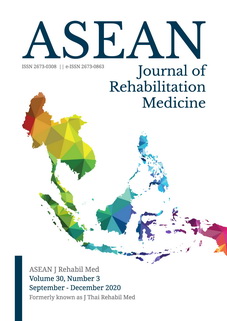Quality of Life in Stroke Patients at Outpatient Rehabilitation Clinic, Siriraj Hospital
Keywords:
stroke, quality of life, depression, outpatients, rehabilitationAbstract
Objectives: To study quality of life in stroke patients measured with Stroke Impact Scale (SIS) and related factors.
Study design: Descriptive study
Setting: Department of Rehabilitation Medicine, Siriraj Hospital
Subjects: Stroke patients at outpatient clinic, Department of Rehabilitation Medicine, Siriraj Hospital
Methods: Data collection and interview by questionnaire: demographic data, Thai version of SIS 3.0, modified version of Rankin scale (MRS), the Barthel index (BI) and the Patient Health Questionnaire-9 (PHQ9) Thai version.
Results: There were 175 stroke patients with an average age 63 years old (SD 11.4). The study revealed 59.4% males, 65.7% ischemic stroke, 82.9% first time stroke, 50.9% history of inpatient rehabilitation admission and 60% spasticity. Common comorbidities were 88.6% hypertension, 76.6% dyslipidemia, 32.6% diabetes mellitus and 18.9% heart disease. SIS score in descending order were communication 94.1 (12.0), memory and thinking 89.8 (16.2), emotion 72.7 (16.0), participation in social 64.8 (21.1), activities of daily living 62.6 (27.6), mobility 59.7 (31.5), the self-recovery rating 56.6 (22.2), the use of the weak hand 44.4 (36.9) and the strength of the body 40.8 (21.2) respectively. The mean of SIS composite physical domain was 51.9 (25.6). The factors that correlated with quality of life SIS composite physical domain were ability to perform activities of daily living by BI score (p <0.001), disability level by MRS (p < 0.001), spasticity (p < 0.05) and depression by PHQ9 score (p < 0.05).
Conclusion: Stroke affects quality of life in domains of body strength and the use of the weak hand more than other domains. The important factors were ability to perform activities of daily living by BI score and depression by PHQ9 score. Therefore, this study suggested that rehabilitation program to increase ability to perform activities of daily living and treatment of depression would improve quality of life.
Keywords: stroke, quality of life, depression, outpatients, rehabilitation
References
Aekplakorn W. Report of the 5th Thai National Health Examination Survey in 2557BE. Nonthaburi: Health Systems Research Institute; 2016.
Suwanwela NC. Stroke epidemiology in Thailand. J Stroke. 2014; 16:1-7.
World Health Organization. [Internet]. Comparative country studies on health system responses to population ageing and noncommunicable diseases in Asia. WHO, 2013 [cited 2017 Oct 24]. Available from: http://www.wpro.who.int/entity/asia_pacific_observatory/country_comparative_studies/apo-ccs-ageing5b_chapter04.pdf.
Rachpukdee S, Howteerakul N, Suwannapong N, Tang-Aroonsin S. Quality of life of stroke survivors: a 3-month follow-up study. J Stroke Cerebrovasc Dis. 2013;22:e70-8.
Manimmanakorn N, Vichiansiri R, Nuntharuksa C, Permsirivanich W, Kuptniratsaikul V. Quality of life after stroke rehabilitation among urban vs. rural patients in Thailand. J Med Assoc Thai. 2011;91:394-9.
Ploypetch T, Dajpratham P. Change in quality of life of disabled patients after intensive inpatient rehabilitation at Siriraj Hospital. J Med Assoc Thai. 2011;94:1245-51.
Duncan PW, Bode RK, Min Lai S, Perera S, Glycine antagonist in neuroprotection Americans I. Rasch analysis of a new stroke-specific outcome scale: the Stroke Impact Scale. Arch Phys Med Rehabil. 2003;84:950-63.
Lai SM, Perera S, Duncan PW, Bode R. Physical and social functioning after stroke: comparison of the Stroke Impact Scale and Short Form-36. Stroke. 2003;34:488-93.
Garnjanagoonchorn A, Dajpratham P. Reliability and validity of the Thai Version of the Stroke Impact Scale (SIS) 3.0. J Thai Rehabil Med. 2015;25:45-52.
Train the Brain Forum committee. Thai Mental State Examination (TMSE). Siriraj. Hosp Gaz. 1993;45:359-74.
Mahoney FI, Barthel DW. Functional Evaluation: the Barthel index. Md State Med J. 1965;14:61-5.
The Internet Stroke Center [Internet]. The Barthel Index; 2011 [cited 2016 Oct 19]. Available from:http://www.strokecenter.org/wp-content/uploads/2011/08/barthel.pdf/
De Wit L, Putman K, Devos H, Brinkmann N, Dejaeger E, De Weerdt W, et al. Five-year mortality and related prognostic factors after inpatient stroke rehabilitation: a European multi-centre study. J Rehabil Med. 2012;44:547-52.
Lotrakul M, Sumrithe S, Saipanish R. Reliability and validity of the Thai version of the PHQ-9. BMC Psychiatry. 2008;8:46.
Williams LS, Brizendine EJ, Plue L, Bakas T, Tu W, Hendrie H, et al. Performance of the PHQ-9 as a screening tool for depression after stroke. Stroke. 2005;36:635-8.
van Swieten JC, Koudstaal PJ, Visser MC, Schouten HJ, van Gijn J. Interobserver agreement for the assessment of handicap in stroke patients. Stroke. 1988;19:604-7.
Bonita R, Beaglehole R. Recovery of motor function after stroke. Stroke. 1988;19:1497-500.
Rehabilitation Measures Database [Internet]. Rehabilitation Institute of Chicago; 2010 [cited 2016 Oct 19]. Available from: http://www.rehabmeasures.org/Lists/RehabMeasures/DispForm.aspx?ID=921
Carod-Artal FJ, Trizotto DS, Coral LF, Moreira CM. Determinants of quality of life in Brazilian stroke survivors. J Neurol Sci. 2009;284:63-8.
Bohannon RW. Muscle strength and muscle training after stroke. J Rehabil Med. 2007;39:14-20.
Broeks JG, Lankhorst GJ, Rumping K, Prevo AJ. The long-term outcome of arm function after stroke: results of a follow-up study. Disabil Rehabil. 1999;21:357-64.
Kong KH, Yang SY. Health-related quality of life among chronic stroke survivors attending a rehabilitation clinic, Singapore Med J. 2006;47:213-8.
Kamel A, Ghani AA, Zaiton MA, El-Motayam AS, El-Fattah DA. Health related quality of life in stroke survivors measured by the Stroke Impact Scale. Egypt J Neurol Psychiatry Neurosurg. 2010;47:267-74.
Singhpoo K, Charerntanyarak L, Ngamroop R, Hadee N, Chantachume W, Lekbunyasin O, et al. Factors related to quality of life of stroke survivors. J Stroke Cerebrovasc Dis. 2012;21:776-81.
Aniwattanapong D. Post-stroke depression. J Psychiatr Assoc Thailand. 2018;63:383-418.
Kuo C-L, Hu G-C. Post-stroke spasticity: a review of epidemiology, pathophysiology, and treatments. International Journal of Gerontology. 2018;12:280-4.
Gillard PJ, Sucharew H, Kleindorfer D, Belagaje S, Varon S, Alwell K, et al. The negative impact of spasticity on the health-related quality of life of stroke survivors: a longitudinal cohort study. Health Qual Life Outcomes. 2015;13:159.
Harnphadungkit K, Poompreecha K. Prevalence of complementary and alternative medicine used by stroke patients in Siriraj hospital, Thailand. ASEAN J Rehabil Med. 2020;30:26-31.






